-
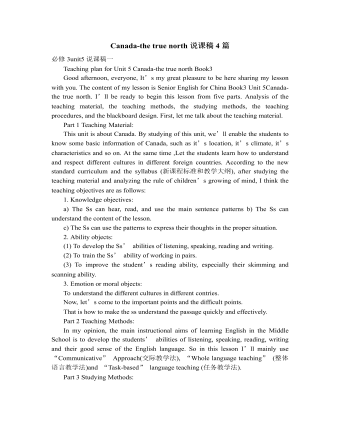
人教版高中英语必修3Canada-the true north说课稿4篇
Good afternoon, teachers, It’s my great pleasure to be here sharing my lesson with you.The content of my lesson is Senior English Book 3 Unit 5 Canada —— “The true North”.I’ll be ready to begin this lesson from five parts. Analysis of the teaching material,the teaching methods,the studying methods, the teaching procedure,and Blackboard design.First, let me talk about the teaching material.Part 1 Teaching Material:This unit is about the introduction of Canada. By studying of this unit,we’ll enable the students to learn the geography, population, main cities, and natural beauty, natural resources of Canada. Through the training of the unit, it also requires students to learn some Language skills such as the expressions of position and emotions.So it plays an important part in the English teaching in this book.After studying the teaching material and analyzing the rule of children’s growing of mind,I think the teaching aims are the followings:1.Knowledge objects:(1) make the students learn some new words and phrases(2) make the students understand the content of the lesson.2.Ability objects:(1)To develop the Ss’ abilities of listening, speaking, reading and writing. Especially reading and speaking ability.(2) learn to talk about the characters of Canada in English(3)To train the Ss’ ability of working in pairs.3.Emotion objects:(1)Enable students to understand the characters of Canada..(2)Stimulate Ss to work hard to make China stronger.Part 2 Teaching Methods:I think helping students learn to master new words and phrases and improve the students’ reading and speaking ability is import and the difficult.According to the analysis of the teaching material and the import points and the difficult points,I will use the following teaching methods : question-guiding approach; fast-reading and careful reading; multi-media teaching methods; discussion
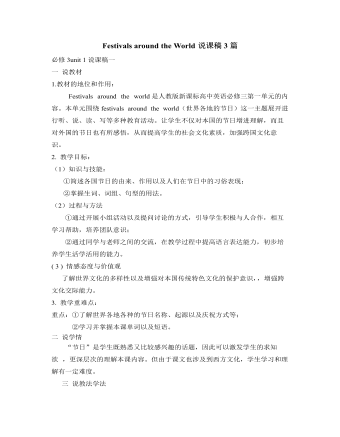
人教版高中英语必修3Festivals around the World说课稿3篇
Teaching plan for Unit 1 book3Good morning, teachers. It’s my great pleasure to be here because I can share my lesson with you and I can learn a lot from it. I’ll begin my lesson from the following four parts, the teaching material, the teaching methods, the studying methods and the teaching procedure.Firstly, let me talk about the teaching material. The content of my lesson is the reading passage festivals and celebrations of Unit 1 Festivals around the world. This passage is about festivals and celebrations. By studying this passage, we’ll enable the students to know that festivals exit everywhere, and many of festivals in different countries celebrate similar ideas. As we all know, the reading passage is the center of each unit. If the Ss can learn it well, it will be helpful to make the Ss learn the rest of this unit.After studying the teaching material, I think the teaching aims are as the followings:1. Knowledge aims:(1) The Ss can master the usage of the important words andexpressions.(2)The Ss can use the __________________ (grammar) in the proper situation.Make students know about the festivals all over the world and the detail of the festivals, such as origin, content, and the date of the holiday festivals.2. Ability aims:(1) Students can talk about festivals and celebrations in English(2) To improve the student’s reading ability, especially their skimming and scanning ability.3. Emotion aims:Make the Ss know about the foreign festivals, and respect other countries’ custom.Next, let’s come to the important points and the difficult points.The important point is how to make the Ss understand the text better and the difficult point is how can they talk about it. secondly, Teaching Methods:1. task-based Language Teaching2. Computer assisted language teaching.3. question-and–answer methodThirdly, Studying Methods:
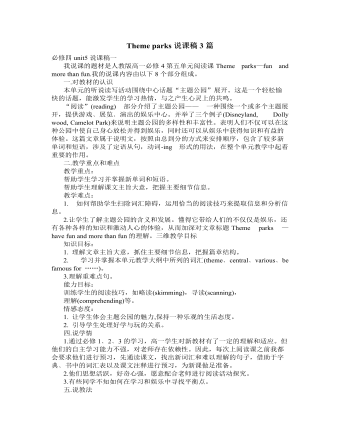
人教版高中英语必修4Theme parks说课稿3篇
The oldest and the most popular park in the worldenjoy the exciting activities thereget close to the life-size cartoon characters like Mickey Mouse and Donald Duck Step 3 Pre-reading1.What do you suppose a theme park is ?2.What do you think you can see in a theme park?(1.It is a kind of amusement park which has a certain theme – that the whole park is based on. 2.buildings, castles, statues, rare animals and birds, and so on.) Step 4 Reading ----- Theme Parks –---- Fun and More Than Fun1.Predict : Read the title and the pictures on P. 34 and PredictWhat is the meaning of the title “Theme Park – Fun and more than fun”?(The title means that theme parks are fun to visit, but that they can also be educational and can offer useful information.)2.Skimming Fast read and answer:What activities can we take in a theme park?Amusement park: Bumper car Merry-go-round slide bungee jumping Free-fall rides Horror films Pirate ship Ferris wheel roller coaster3.Scanning Read again and you will find various theme parks are mentioned in the passage . Then what are they ?Theme parks: Sports theme park History theme park Culture theme park Marine or Ocean theme Park Future park Science theme park Disneyland4.Careful reading and find the main idea of each paragraph:THEME PARKS---- entertaining/ educationalPara.1 Traditional parks are places to go for relaxation and to have time away from our busy lives.Para.2 Theme parks are different They’re large and full of things to do, see and buy.Para.3 Theme parks are built around a single idea or theme. One example is a sports park.Para.4 Another kind of theme park is historical more and cultural and can be educational.Para.5 Disneylandwas the first theme park. It is based on the fantasy life and characters of Disney’s films.Para.6 Some examples of educational theme parks include sea world parks and science parks.
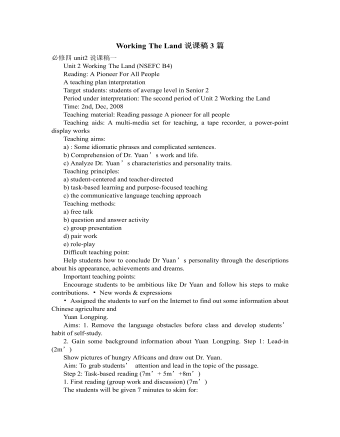
人教版高中英语必修4Working The Land说课稿3篇
Knowledge objectives:(1) to make Ss grasp the usage of words, expressions and sentence structures: statistics, struggle, thanks to, rid of, some patterns for persuasion, the “ing” form as subject and object;(2)to use learnt knowledge to persuade sb.Ability objectives:(1) to develop Ss’ reading skills(skimming, scanning, word guessing);(2) to improve Ss’ speaking, communicating and cooperating skills.Emotional objectives:to make Ss know the contribution of Yuan,and learn his spirit and his simple life time.Teaching important and difficult points:(1) some words, expressions and sentence structures mentioned above;(2)the content of the text;(3)training their reading and speaking skills.Teaching methods: CLT, TBLT,QT.Learning strategies: CLS, QLS, TBLS.Teaching procedures:Step 1 lead-in: (1) teacher plays a piece of recent news from CCTV about the harvest of the super hybrid rice, and ask students whether they know Yuan or not, and talk about him and his contribution.(2)Brain storm: let Ss describe Yuan in their minds including his appearance, his living condition and so on.Step 2 fast reading tasks:(1)teacher introduces Yuan and super hybrid rice(2)make Ss read the text as fast as possible with questions. Such as: what’s the general ideaof this passage? What’s Yuan’ dream? (skimming and scanning skill)Step 3 intensive reading tasks(1)let Ss read the text silently, find topic sentence of each paragraph and draw the difficult sentences and the knowledge what they don’t understand.(words guessing)(2)teacher and Ss talk about the important words, expressions and sentences together, and ask Ss to retell the content of the text.(summarizing and paraphrasing)(3)teacher summarize this part.(4) read again following the courseware.
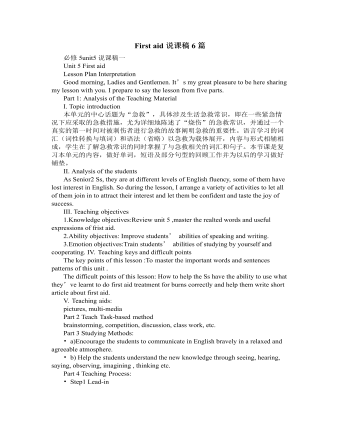
人教版高中英语必修5First aid说课稿6篇
In this class, I have 3 teaching aims, that is, knowledge aims, ability aims and emotion aims.1) Knowledge-Teach students new words and expressions, such as temporary, bleed,sprain choke, first aid, fall ill and so on.-Enable students to have a better understanding for some basic knowledge of first aid.2) Ability-Train students’ speaking, reading and writing abilities by different teaching activities, such as skimming, comprehending, team work, role play, retelling and writing.-Develop students’ reading strategy on how to move general idea to specific information.3) Emotion-Promote students’ awareness of giving first aid.- Cultivate students’ creativities.Then let’s come to my teaching methods and activities.III. Teaching methods and activities:To achieve different teaching aims, various kinds of teaching methods and activities will be adopted throughout this period, such as TBL (task-based learning), skimming, team work, brainstorm and others, which can offer students opportunities to fulfill tasks in which they can use language to achieve a specific outcome.IV. Teaching aids:Computer and blackboardV. Teaching important points:1) Make students have a clear mind for the structure of the text.2) Help students understand the theme of the text.VI. Teaching difficulties:1) So many new words may affect students’ understanding.2) How to get students to know about the functions of the skin and thecauses, characteristics and treatments for different degree burns,and the knowledge about giving first aid. VII. Blackboard design:
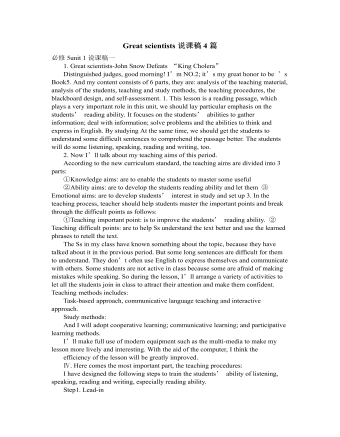
人教版高中英语必修5Great scientists说课稿4篇
通过写文章梗概,培养学生综合运用语言的能力,学习用恰当的英语描述科学家的故事。这是本课的教学难点。教师可以使用完形填空的方式来帮助学生整理语篇,从而来降低难度。本课的教学重点的突破方法是:在阅读前,让学生初步了解得出科学观点所需要的基本程序,从而轻松而自然地导入文章的阅读;在阅读过程中,由易到难设计快速阅读和精读的问题,层层推进各种阅读活动,让学生对阅读内容从整体感知到细节理解,最后深层读懂整篇文章,同时加强阅读策略的指导,让每个学生都主动参与课堂教学活动,最终达到提高阅读能力的目的。Step 4 Post-readingGroup Activities四人小组共同合作,在老师的适当指导下,就以下2个问题展开讨论,让学生就所知、所学、所感和所想融入话题,然后抽若干同学代表作小组发言。1. What do you think about John Snow, and what should we learn from him?2. Cholera was 19th century disease, which two diseases are similar to cholera today? Why?
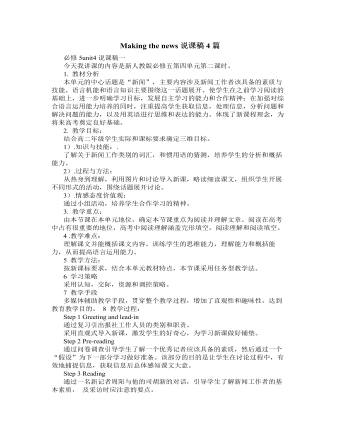
人教版高中英语必修5Making the news说课稿4篇
今天我们来介绍一下必修五第四单元的授课方式。这个单元的题目是Making the news。应该是学生比较感兴趣的话题,学生往往对新闻工作充满好奇,所以我们可以利用这个机会多设计一些师生互动和学生互动,来激发起学习的积极性,提高学习效率。同时我们可以利用这个单元不仅帮助学生掌握语言知识,培养语言能力,同时让其了解新闻工作的重要性,培养起社会智能感。这个单元分为六个课时,它的教学目标是这样的:语言目标是掌握词汇表中的常用单词和短语,掌握倒装句的一些基本用法。 技能目标是能初步掌握约会的基本句型并在真实的场景下正确运用。新闻报道类文章的写作技能。采访的基本规范和沟通技能。情感目标是对新闻报道的客观性和真实性有更好的理解。对新闻记者的职业有更深入的了解,并能体会其工作的重要性。下面我们来介绍一下第一课时的授课方式,第一课的教学目标是这样的第一课时的教学目标语言目标:单词:Occupation, journalist, editor, photographer, curious, personality, enthusiasm
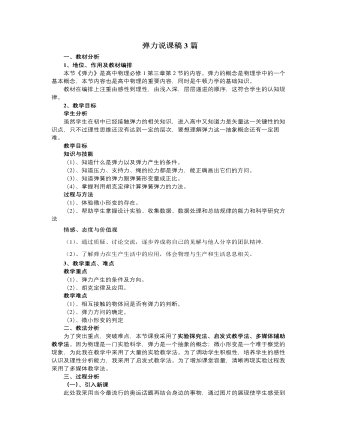
人教版新课标高中物理必修1弹力说课稿3篇
基于以上分析,为使本堂课围绕重点、突破难点,同时让学生在课堂教学中能力得到提高,我设计如下教学过程。(一)创设情景认识形变由同学们已有的形变知识入手,引入新课。教师演示:①弹簧的压缩形变;②弹簧的拉伸形变③视频播放:竹竿形变、钢丝的扭转形变。得出形变的概念及各类形变。[设计意图:我从生活情景中引入新课,是为了激发学生的好奇心,为学生学习重点和难点内容作铺垫。]设问:摩天大楼在风的吹拂下会不会摆动,发生形变吗?演示微小形变放大实验:由于这种形变不容易观察,会使学生产生疑问:到底有没有发生形变?解决的办法是微小形变的演示实验。为什么光点会往下移?让学生带着问题思考后得出结论:是由于桌面发生了形变,但是形变不明显。为后面解决压力和支持力都是弹力做好铺垫。[设计意图:使学生知道“放大”是一种科学探究的方法。]
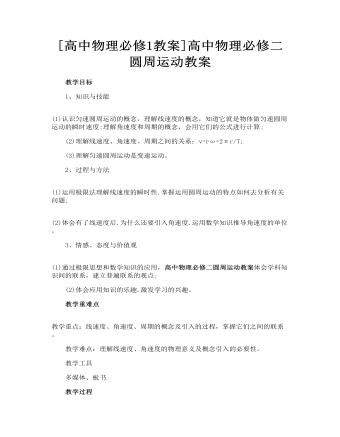
高中物理必修二圆周运动教案
1、知识与技能 (1)认识匀速圆周运动的概念,理解线速度的概念,知道它就是物体做匀速圆周运动的瞬时速度;理解角速度和周期的概念,会用它们的公式进行计算; (2)理解线速度、角速度、周期之间的关系:v=rω=2πr/T; (3)理解匀速圆周运动是变速运动。 2、过程与方法 (1)运用极限法理解线速度的瞬时性.掌握运用圆周运动的特点如何去分析有关问题; (2)体会有了线速度后.为什么还要引入角速度.运用数学知识推导角速度的单位。
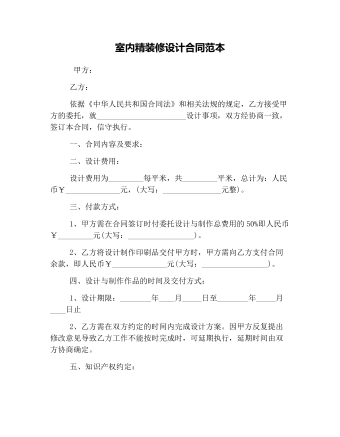
室内精装修设计合同范本
依据《中华人民共和国合同法》和相关法规的规定,乙方接受甲方的委托,就_______________________设计事项,双方经协商一致,签订本合同,信守执行。一、合同内容及要求:二、设计费用:设计费用为_________每平米,共_________平米,总计为:人民币¥______________元,(大写:_______________元整)。三、付款方式:1、甲方需在合同签订时付委托设计与制作总费用的50%即人民币¥_________元(大写:_________________)。2、乙方将设计制作印刷品交付甲方时,甲方需向乙方支付合同余款,即人民币¥______________元(大写:_________________)。四、设计与制作作品的时间及交付方式:1、设计期限:________年____月_____日至________年_____月____日止2、乙方需在双方约定的时间内完成设计方案。因甲方反复提出修改意见导致乙方工作不能按时完成时,可延期执行,延期时间由双方协商确定。五、知识产权约定:1、甲方在未付清所有委托设计制作费用之前,乙方设计的作品著作权归乙方,甲方对该作品不享有任何权利。2、甲方将委托设计制作的所有费用结算完毕后,甲方拥有作品的所有权、使用权和修改权。
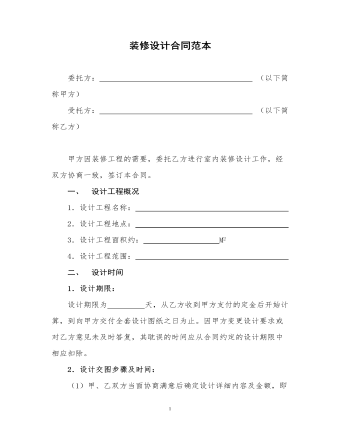
装饰装修设计合同
设计期限为 天,从乙方收到甲方支付的定金后开始计算,到向甲方交付全套设计图纸之日为止。因甲方变更设计要求或对乙方意见未及时答复,其耽误的时间应从合同约定的设计期限中相应扣除。2.设计交图步骤及时间:(1)甲、乙双方当面协商满意后确定设计详细内容及金额,即签定本合同,同时支付定金人民币 元。乙方收到定金后 天内,向甲方提交装修设计方案图及平面功能定位图,如乙方未提交装修设计方案图及平面功能定位图,则双倍向甲方返还定金。 (2)甲、乙双方初步确定平面方案及初步确定设计概念后,同时支付首期设计费人民币 (按以上2(1)支付的人民币定金自动转为首期设计费)。乙方收到设计费后 天内,向甲方提交较详细装修设计方案包括主要立面图。(3)甲方确认立面方案、天花方案即支付第二期设计费人民币,乙方收到设计费案后 天内,向甲方提交详细装修施工图及效果图。(4)甲方签字确认设计施工图后即支付第三期设计费人民币,乙方向甲方提供全套正式设计施工图纸。 (5)工地开工后设计师配合施工队现场指导并对业主提供材料及工程质量咨询服务。
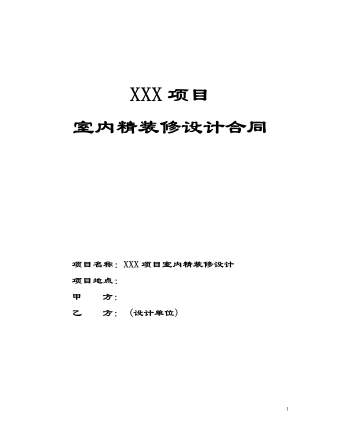
室内精装修设计合同
第一条 定义除上下文另有要求外,以下各词和用语,应具有如下的涵义:1.1 “适用法律”指在中华人民共和国和长沙市已颁布并生效的具有法律效力的法律和其它文件。1.2“服务”指本协议设计任务书所述的,按照协议由乙方完成本项目而进行的工作。1.3 “货币”指人民币元,本协议另有约定的除外。第二条 解释合同文件的组成及优先顺序:(1) 本合同协议(由标准及特殊条件、担保条款(如有)三部分组成)及附件(2) 经甲方认可的乙方承诺(3) 招标文件及其附件(如有)(4) 投标书及其附件(如有)(5) 中标通知书(6) 标准、规范及有关技术文件第三条 项目概况及服务内容、标准3.1 项目概况及服务内容、标准等见第二部分规定。3.2甲方为建造本项目所需要的设计服务的任何内容,并不会因为本协议的局限而被视为遗漏,乙方保证在规定的期限内按质按量完成规划部门、政府相关部门和甲方所需的全部设计文件。第四条 设计服务费4.1 本协议设计服务价格总额及费用明细见第二部分的规定。4.2 本协议第4.1条规定的设计服务价格总额为固定价格,该价格包括所有人员费用、印刷打印出图、电子版图纸刻录费用、通讯、差旅、交通、设计补充完善等所有在乙方执行本协议所述的服务中发生的全部费用。除非另有规定,否则此价格不以任何理由改变。
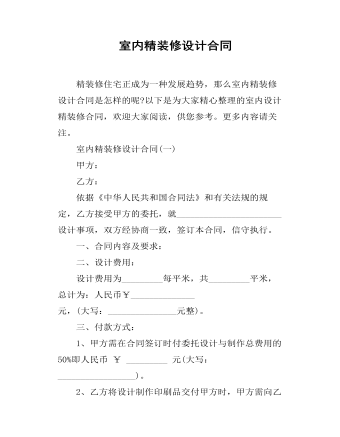
室内精装修设计合同
精装修住宅正成为一种发展趋势,那么室内精装修设计合同是怎样的呢?以下是为大家精心整理的室内设计精装修合同,欢迎大家阅读,供您参考。更多内容请关注。 室内精装修设计合同(一) 甲方: 乙方: 依据《中华人民共和国合同法》和有关法规的规定,乙方接受甲方的委托,就_______________________设计事项,双方经协商一致,签订本合同,信守执行。 一、合同内容及要求: 二、设计费用: 设计费用为_________每平米,共_________平米,总计为:人民币¥______________ 元,(大写:_______________元整)。三、付款方式: 1、甲方需在合同签订时付委托设计与制作总费用的50%即人民币 ¥ _________ 元(大写:_________________)。 2、乙方将设计制作印刷品交付甲方时,甲方需向乙方支付合同余款,即人民币¥______________元(大写:_________________
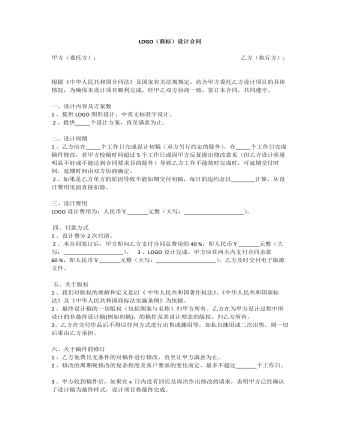
LOGO(商标)设计合同
甲方(委托方): 乙方(执行方): 根据《中华人民共和国合同法》及国家有关法规规定,结合甲方委托乙方设计项目的具体情况,为确保本设计项目顺利完成,经甲乙双方协商一致,签订本合同,共同遵守。 一、设计内容及方案数 1 、提供LOGO图形设计,中英文标准字设计。 2 、提供_____个设计方案,直至满意为止。 二、设计周期 1 、乙方应在_____个工作日完成设计初稿(双方另行约定的除外)。在_____个工作日完成稿件修改,若甲方校稿时间超过5个工作日或因甲方反复提出修改意见(但乙方设计质量明显不好或不能达到合同要求目的除外)导致乙方工作不能按时完成时,可延期交付时间,延期时间由双方协商确定。 2 、如果是乙方单方的原因导致不能如期交付初稿,每日的违约金以________计算,从设计费用里面直接扣除。 三、设计费用 LOGO设计费用为:人民币¥_______元整(大写:____________________)。 四、付款方式 1 、设计费分 2 次付清。 2 、本合同签订后,甲方即向乙方支付合同总费用的40 %,即人民币¥_______元整(大写:____________________)。 3 、LOGO设计完成,甲方应在两天内支付合同余款60 %,即人民币¥_______元整(大写:____________________)。乙方及时交付电子版源文件。
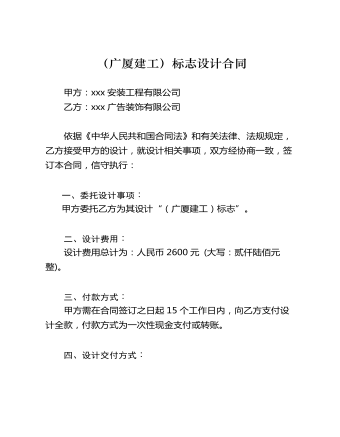
(广厦建工)标志设计合同
甲方:xxx安装工程有限公司 乙方:xxx广告装饰有限公司依据《中华人民共和国合同法》和有关法律、法规规定,乙方接受甲方的设计,就设计相关事项,双方经协商一致,签订本合同,信守执行: 一、委托设计事项:甲方委托乙方为其设计“(广厦建工)标志”。二、设计费用:设计费用总计为:人民币2600元 (大写:贰仟陆佰元整)。三、付款方式:甲方需在合同签订之日起15个工作日内,向乙方支付设计全款,付款方式为一次性现金支付或转账。四、设计交付方式:1、乙方自合同签订之日起15日内,以电子稿形式向甲方交付设计方案。
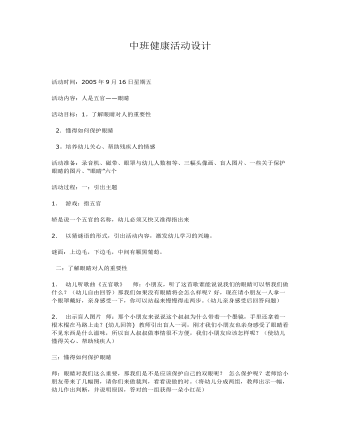
中班健康活动设计
活动内容:人是五官——眼睛活动目标:1。了解眼睛对人的重要性 2.懂得如何保护眼睛 3。培养幼儿关心、帮助残疾人的情感活动准备:录音机、磁带、眼罩与幼儿人数相等、三幅头像画、盲人图片、一些关于保护眼睛的图片、“眼睛”六个活动过程:一:引出主题1. 游戏:指五官轿是说一个五官的名称,幼儿必须又快又准得指出来2看说贴得准。活动
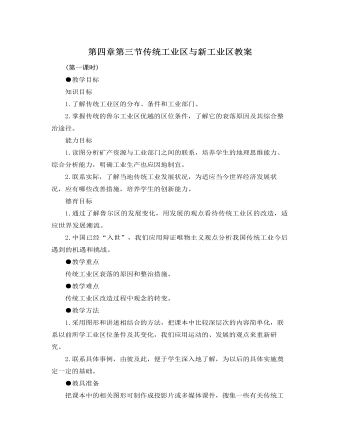
人教版新课标高中地理必修2第四章第三节传统工业区与新工业区教案
知识目标1.了解传统工业区的分布、条件和工业部门。2.掌握传统的鲁尔工业区优越的区位条件,了解它的衰落原因及其综合整治途径。能力目标1.读图分析矿产资源与工业部门之间的联系,培养学生的地理思维能力、综合分析能力,明确工业生产也应因地制宜。2.联系实际,了解当地传统工业发展状况,为适应当今世界经济发展状况,应有哪些改善措施,培养学生的创新能力。德育目标1.通过了解鲁尔区的发展变化,用发展的观点看待传统工业区的改造,适应世界发展潮流。2.中国已经“入世”,我们应用辩证唯物主义观点分析我国传统工业今后遇到的机遇和挑战。
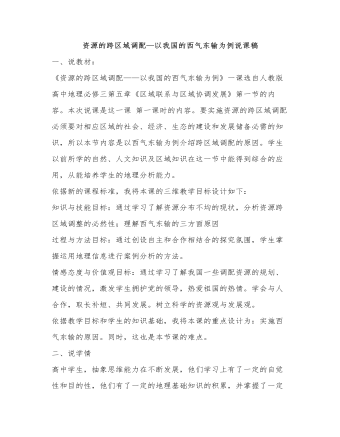
人教版高中地理必修3资源的跨区域调配—以我国的西气东输为例说课稿
由于这部分知识已要求学生在课前收集相关资料探讨分析,,现在提供机会让他们进行交流,充分发表各自的见解。所以,学生对这个知识掌握起来并不难。所以,我对这部分内容不做太多的讲解,只要做进一步的梳理,加深学生的理解即可。 第三是小结环节 在学生对西气东输工程的原因掌握之后进入的是小结环节,这里我进一步提出问题:在西气东输工程段的建设中有没有什么难关? 通过西气东输的难度了解,间接的表现我国的科技的发展,增加学生的爱国情,同时也说明西气东输的建成也有技术这一原因。从而也完成了本课时的小结。 第四环节是作业布置 在这里要求学生课后预习本课剩下的内容:思考西气东输对区域发展的影响以及为何要实施资源的跨区域调配。通过这样的问题一方面为下节课学习奠定基础,另一方面体现本课学习从“个”到“类”从特殊到一般的过程。

人教版新课标高中物理必修1用牛顿运动定律解决问题(二)教案2篇
观察实验视频实验验证师:其实大家完全可以利用身边的器材来验证。实验1、用弹簧秤挂上钩码,然后迅速上提和迅速下放。现象:在钩码被迅速上提的一瞬间,弹簧秤读数突然变大;在钩码被迅速下放的一瞬间,弹簧秤读数突然变小。师:迅速上提时弹簧秤示数变大是超重还是失重?迅速下放时弹簧秤示数变小是超重还是失重?生:迅速上提超重,迅速下放失重。体会为何用弹簧秤测物体重力时要保证在竖直方向且保持静止或匀速实验2、学生站在医用体重计上,观察下蹲和站起时秤的示数如何变化?在实验前先让同学们理论思考示数会如何变化再去验证,最后再思考。(1)在上升过程中可分为两个阶段:加速上升、减速上升;下蹲过程中也可分为两个阶段:加速下降、减速下降。(2)当学生加速上升和减速下降时会出现超重现象;当学生加速下降和减速上升时会出现失重现象;(3)出现超重现象时加速度方向向上,出现失重现象时加速度方向向下。完全失重
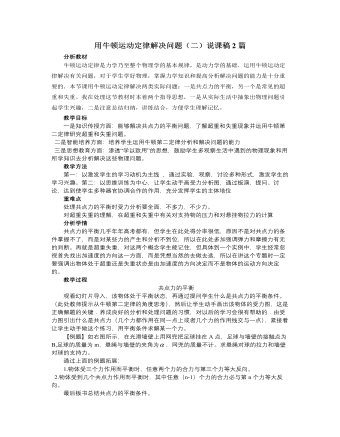
人教版新课标高中物理必修1用牛顿运动定律解决问题(二)说课稿2篇
教师活动:(1)组织学生回答相关结论,小组之间互相补充评价完善。教师进一步概括总结。(2)对学生的结论予以肯定并表扬优秀的小组,对不理想的小组予以鼓励。(3)多媒体投放板书二:超重现象:物体对支持物的压力(或对悬挂物的拉力)大于物体所受到的重力的情况称为超重现象。实质:加速度方向向上。失重现象:物体对支持物的压力(或对悬挂物的拉力)小于物体所受到的重力的情况称为失重现象。实质:加速度方向向下。(4)运用多媒体展示电梯中的现象,引导学生在感性认识的基础上进一步领会基本概念。4.实例应用,结论拓展:教师活动:展示太空舱中宇航员的真实生活,引导学生应用本节所学知识予以解答。学生活动:小组讨论后形成共识。教师活动:(1)引导学生分小组回答相关问题,小组间互相完善补充,教师加以规范。(2)指定学生完成导学案中“思考与讨论二”的两个问题。

